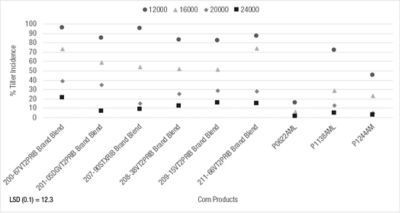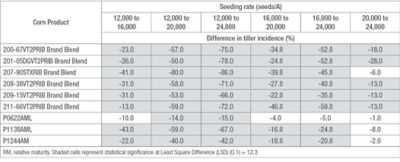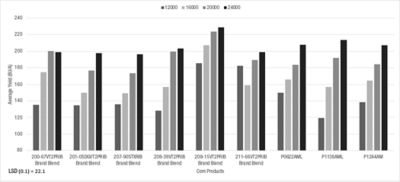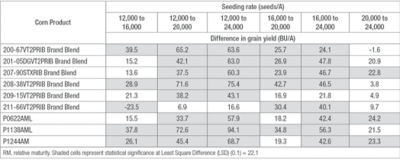Dryland Corn Seeding Rates Effect on Product Yield - Channel
February 16, 2022
TRIAL OBJECTIVE
Selecting appropriate products and seeding rates are key to helping achieve high yield potential in dryland corn production.
Low corn populations can promote the formation of tillers (a.k.a. “suckers”). There is controversy as to whether tillers compensate for grain yield by producing more than one ear per plant.
The objective of this trial was to determine the effect of corn seeding rate on tiller incidence and grain yield for different corn products.
RESEARCH SITE DETAILS
Previous
Crop Wheat Tillage
Type No-Tillage
Potential Yield
(bu/acre) 200 Seeding Rate
(seeds/acre) See Below
The trial was set up as a randomized complete block design with four replications.
Nine corn products were evaluated with six Channel® and three Pioneer® brand corn products with relative maturities (RM) ranging from 100 to 112 days.
The four corn seeding rates used were 12,000, 16,000, 20,000, and 24,000 seeds/acre.
Tiller incidence was measured as a percentage of the number of plants that presented tillers relative to the total number of plants in the plot.
Corn was fertilized with a stream bar before planting (04/06/2021) with 90 lb/acre of nitrogen (N), 40 lb/acre of phosphorus (P), and 20 lb/acre of sulfur (S). Nitrogen was also side-dressed on 06/22/2021 using Y-drops at 60 lb/acre.
Weeds were controlled uniformly across the study area.
UNDERSTANDING THE RESULTS

There was a significant interaction between product and seeding rate in tiller incidence in this study.
Even though tiller incidence varied by corn products, a greater tiller incidence was observed under lower corn seeding rates of 12,000 and 16,000 seeds/acre compared to higher seeding rates of 20,000 to 24,000 seeds/acre (Figure 1).

All Channel® brand corn products significantly reduced tiller incidence as the seeding rate increased. However, only one Channel® corn product, 207-90STXRIB, did not significantly reduce tiller incidence from 20,000 to 24,000 seeds/acre.
The tiller incidence reduction from 12,000 to 20,000, and from 12,000 to 24,000 seeds/acre was significant for all Channel® and Pioneer® brand corn products evaluated (Table 1).

- There was a trend of greater corn grain yield as seeding rates were increased across corn products tested in this study (Figure 2).

The corn grain yield response to seeding rate was product selection dependent. Most of the differences in grain yield between different seeding rate increments were observed from 12,000 to 20,000; 12,000 to 24,000; 16,000 to 20,000; and 16,000 to 24,000 seeds/acre (Table 2).
The least grain yield differences in the corn products tested were observed from 12,000 to 16,000, and from 20,000 to 24,000 seeds/acre (Table 2).
KEY LEARNINGS
Lower corn seeding rates yielded less than higher seeding rates and produced more tillers. Tillers did not compensate for grain yield.
The presence of tillers was not associated with reduced corn grain yield as tiller incidence and yield was compared across products.
- Talk to your local Channel Seedsman to determine which corn products and seeding rates best fit your production system.
3021_R3
Seed Brands & Traits
Crop Protection
Disclaimer
Always read and follow pesticide label directions, insect resistance management requirements (where applicable), and grain marketing and all other stewardship practices.
©2024 Bayer Group. All rights reserved.